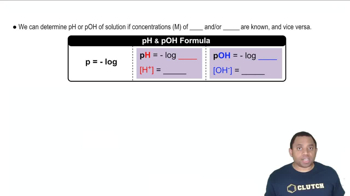Here are the essential concepts you must grasp in order to answer the question correctly.
Buffer Solutions
Buffer solutions are mixtures that resist changes in pH when small amounts of acid or base are added. They typically consist of a weak acid and its conjugate base or a weak base and its conjugate acid. In this case, CH3NH2 (methylamine) acts as the weak base, while CH3NH3Cl (methylammonium chloride) serves as its conjugate acid.
Recommended video:
Henderson-Hasselbalch Equation
The Henderson-Hasselbalch equation is a mathematical formula used to calculate the pH of a buffer solution. It is expressed as pH = pKa + log([A-]/[HA]), where [A-] is the concentration of the base and [HA] is the concentration of the acid. This equation allows for the determination of the required ratio of base to acid to achieve a desired pH.
Recommended video:
Henderson-Hasselbalch Equation
pKa and pH Relationship
The pKa is the negative logarithm of the acid dissociation constant (Ka) and indicates the strength of an acid in solution. The relationship between pKa and pH is crucial for buffer calculations, as it helps determine how much of the acid and base components are needed to achieve a specific pH. For a buffer to be effective, the pH should be close to the pKa of the weak acid or base involved.
Recommended video:

 Verified step by step guidance
Verified step by step guidance


